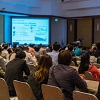By Joining you agree to MachPrinciple's Terms and Conditions and Privacy Policy
Click to Login
Please check your email. A registration confirmation link will be sent to your mailbox..
A registration confirmation link has been sent to your email. Please check your email and finish the registration process.

Search a Conference through our dedicated search page

Locomotion of cells, both individually and collectively, plays an important role in development, the immune response, wound healing, and cancer metastasis. Movement requires force transmission to the environment, and motile cells are robustly-designed nanomachines that often can cope with a variety of environmental conditions by altering the mode of force transmission – which ranges from crawling to swimming. The shape and integrity of a cell is determined by its cytoskeleton, and thus the shape changes that may be required to move involve controlled remodeling of the cytoskeleton. Motion in vivo is often in response to extracellular signals, which requires the ability to detect such signals and transduce them into the shape changes and force generation needed for movement. Thus the nanomachine is complex, and while much is known about individual components involved in movement, an integrated understanding of single cell motility, even in simple cells such as bacteria, is not at hand. At the next level, collective movement requires coordination of these nanomachines, which introduces another level of complexity. This complexity has stimulated mathematical modelling and computational simulations of cell and tissue movement at various levels, which has advanced our understanding of movement on multiple time and space scales.
